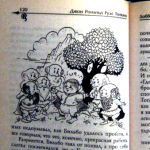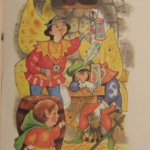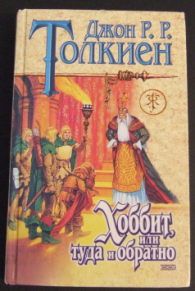Хоббит, или Туда и обратно
Last week was another book sale at my library. I picked up a Teach Yourself Colloquial Arabic and one other. I found the colloquial Arabic interesting since it did not use Arabic script for the Arabic phrases. Instead, the book uses romanization. This may come in handy when looking for some conlanging inspiration, so that’s now in my personal collection.
The other is the Tolkien’s The Hobbit in Russian: Хоббит, или Туда и обратно. The first thing I noticed was that the cover sported the famous Darrell Sweet painting of Thorin and Thranduil, the Elven King. Not sure if all the copyrights were adhered to, but it’s a handsome picture:
The volume also includes translations of Farmer Giles of Ham, Leaf by Niggle, and Smith of Wooton Major, all with different illustration styles. Farmer Giles includes the well-known artwork of Pauline Baynes. Last year, I passed up a complete collection of The Lord of the Rings in Russian and still kick myself. No, I can’t read Russian, but it’s very interesting to be able to see how names and other items (e.g., maps) are handled in other languages. I know just enough Cyrillic to be able to puzzle out individual words and names. Хоббит, или Туда и обратно is also illustrated in the manner of a children’s book. While The Hobbit could be considered a children’s book, the illustrations seem at odd with the sometimes dark themes of the story. For example, here’s an illustration of the dwarves and Bilbo:  The book also includes some nice maps, such as this one of the Battle of Five Armies:
The book also includes some nice maps, such as this one of the Battle of Five Armies:  (You can see the arrows denoting where the orki are coming from.). Finally, one of the more disturbing pieces from the book are the elves which have wings. Yes, wings:
(You can see the arrows denoting where the orki are coming from.). Finally, one of the more disturbing pieces from the book are the elves which have wings. Yes, wings:  This is obviously the scene with Bilbo finding the way out of the Elven King’s halls through the empty wine barrels. But those wings… That’s a new one. Even so, it’s interesting to get a new perspective on the adventures of Бильбо БÑггинÑ, ГÑÌндальф, Торин and all the rest.
This is obviously the scene with Bilbo finding the way out of the Elven King’s halls through the empty wine barrels. But those wings… That’s a new one. Even so, it’s interesting to get a new perspective on the adventures of Бильбо БÑггинÑ, ГÑÌндальф, Торин and all the rest.
A Little Lexical Inspiration
I recently picked up the book Pacific Languages: An Introduction by John Lynch from the library and was leafing through it. Lots and lots of food for thought from languages from Adzera to Yukulta. This evening, as I was looking over Chapter 11 (Language, Society and Culture in the Pacific), and found some good lexical inspiration. I’ve read a number of times on various conlanging listservs and boards about looking for different ways to split up concepts that may be lumped together in one’s own language. Well, from this book, it appears Yidiny does a good job of illustrating this:
dalmba – sound of cutting
mida – the noise of a person clicking his tongue against the roof of his mouth, or the noise of an eel hitting the water
maral – the noise of hands being clapped together
nyurrugu – the noise of talking heard a long way off when the words cannot quite be made out
yuyurunggul – the noise of a snake sliding through the grass
gangga – the noise of some person approaching, for example, the sound of his feet on leaves or through the grass — or even the sound of a walking stick being dragged across the ground
I for one would not have thought of assigning lexemes to those concepts.
Additionally, Pacific Languages: An Introduction provides a reminder that even different stages of a coconut’s growth can be assigned different words: a coconut fruit bud (iapwas), young coconut before meat has begun to form (tafa), nut with hard well-developed meat (kahimaregi), etc., etc., etc.
Hmmm, all these languages have me thinking about my own Elasin after a looong hiatus. Might be time to go back and start “reconstructing” the work of Paiwon Lawonsa on the Uhanid languages.
Don’t Sleep, There Are Snakes: A Conlanger’s Review
Don’t Sleep, There Are Snakes: Life and Language in the Amazonian Jungle recounts the experiences and research of author Daniel Everett with the Pirahã. Their language, also known as Pirahã, is notorious in linguistics circles for numerous traits uncovered by Everett. The New Yorker published an extensive article about Everett and his work in 2007 that does a good job of introducing readers to the controversy. Being neither a professional linguist nor having a particular linguistic axe to grind, I can’t contribute anything to that debate (nor would I want to wade into those waters); however, I can share some thoughts on the book and its story from a layperson’s perspective as well as provide some interesting conlinguistic titbits that the book has to offer.
The book’s title comes from a common "Good night" phrase that the Pirahã say and is good advice for a culture living deep in the Amazon jungle. The native culture in which Everett and his family find themselves is vividly portrayed (and not sugar-coated). The book’s first section, roughly two-thirds, recounts the story of Everett and his family among the Pirahã; the last third goes into more depth on the Pirahã language itself. Both sections are fascinating and include glimpses of the missionary zeal of Everett and his wife, unsettling cultural practices of the Pirahã, humorous cross-cultural incidents, and much more.
As usual, in book reviews here at The Conlanging Librarian, let’s examine some interesting linguistic twists that an enterprising conlanger might take advantage of from Pirahã. We’ll avoid the ones that many people may already know, including the language’s lack of recursion (see here). The first concept that struck me was the idea of kagi. Let’s take some examples from the text to see this in action first:
- “rice and beans” could be termed "rice with kagi"
- Dan arrives in the village with his children: "Dan arrived with kagi"
- Dan arrives in the vilage with his wife: "Dan arrived with kagi"
- A person goes to hunt with his dogs: "He went hunting with kagi"
Everett ends up translating the term kagi as "expected associate" with the expectation being culturally determined. A man's wife is expected to be associated with him. One expects a person to go hunting with his dogs. And so on.
The terms bigí and xoí are also associated with a culturally-determined meaning. The Pirahã believe in a layered universe. The bigí is the boundary between those layers. The xoí is the entire biosphere between bigí. To go into the jungle is to go deeper into the xoí. To remain motionless in a boat is to stay still in the xoí. If something falls from the sky, it may be said to come from the upper bigí. This way of dividing up the universe is similar in some ways to the way Deutscher described splitting up the visible spectrum in his book. Deutscher’s book also mentions fixed directional systems, and the Pirahã also use an upriver-downriver fixed point system instead of our left-right orientation. I still find this an interesting set of concepts to play with in a conlang.
Everett also contends that the Pirahã do not have a number system. According to him, they use a system of relative volume: hoi can appear to mean "two" but, in reality, can mean simply that two small fish or one medium fish are relatively smaller that a hoi fish. Everett recounts the trials of attempting to teach a number of Pirahãs to count in Portuguese, with very little success. He even goes so far as to say that there are not even words for quanitifers like "all, each, every, and so on." Instead, there are "quantifierlike" words (or affixes) that translate as "the bulk of" (Lit., the bigness of) the people went swimming and other relative terms. There are other words that mean the whole or part of something (usually something eaten). This way of looking at amounts, numbers, portions, etc., is fertile ground on which to play once again.
Finally (but no means the last intriguing concept in the book), Everett talks about the tribe's use of the term xibipíío which, loosely translated, means something like "the act of just entering or leaving perception, that is, a being on the boundaries of experience". "The match began to flicker. The men commented, 'The match is xibipíío-ing' . . . A flickering flame is a flame that repeatedly comes and goes out of experience or perception." However, the word can also be used for someone disappearing in a canoe around the bend in a river or for an airplane that just comes into view over the trees. The word has much wider connotations that an English-speaker saying something appears or disappears.
I have no idea what Everett thinks of conlangers or the art of language creation or if he is even aware of us. The final section of the book is entitled "Why Care About Other Cultures and Languages?" and lays out a good rationale for why this is important. In the end, there really is no comparison between language creation and preserving endangered languages. As M.S. Soderquist said on CONLANG-L: Creating a new hobby language doesn’t affect natural languages any more than playing Monopoly affects the economy. Conlangers can get their inspirations from any source, and Don’t Sleep, There Are Snakes: Life and Language in the Amazonian Jungle is a treasure trove of novel ideas as well as a a glimpse into another world and another culture and another way of seeing the world.
New Book by Guy Deutscher
One of my favorite books on language is Guy Deutscher’s The Unfolding of Language. It’s accessible, informative, and just a lot of fun to read. Well, I just discovered that he’ll be coming out with a new one on August 31 (That’s in 2 days!): Through the Language Glass. Here’s the product description from Amazon.com:
Linguistics has long shied away from claiming any link between a language and the culture of its speakers: too much simplistic (even bigoted) chatter about the romance of Italian and the goose-stepping orderliness of German has made serious thinkers wary of the entire subject. But now, acclaimed linguist Guy Deutscher has dared to reopen the issue. Can culture influence language—and vice versa? Can different languages lead their speakers to different thoughts? Could our experience of the world depend on whether our language has a word for “blue”?
Challenging the consensus that the fundaments of language are hard-wired in our genes and thus universal, Deutscher argues that the answer to all these questions is—yes. In thrilling fashion, he takes us from Homer to Darwin, from Yale to the Amazon, from how to name the rainbow to why Russian water—a “she”—becomes a “he” once you dip a tea bag into her, demonstrating that language does in fact reflect culture in ways that are anything but trivial. Audacious, delightful, and field-changing, Through the Language Glass is a classic of intellectual discovery.
Of course, I haven’t read it yet, but I’m looking forward to posting a review. There is an adaptation from an excerpt posted as an article online: “Does Your Language Shape How You Think?”. It’ll be interesting to see Deutscher’s take on the classic debate. Can’t wait.
Latin comes to Facebook
The Conlanging Librarian has been lax in his duties, and this news item was too good to pass up. Although Latin is decidedly not a conlang, it is an inspiration to many conlangers, both novices and advanced practioners. Latin…it’s not just for Cicero anymore!
English…mugging other languages
Okay, so it’s not conlanging, but this quote has stuck with me since I saw it on a t-shirt at Tekkoshocon several years ago:
“Not only does the English Language borrow words from other languages, it sometimes chases them down dark alleys, hits them over the head, and goes through their pocketsâ€
Today, I remembered it again and decided to see if I could find a source. Turns out there’s several attributions. Many sites on the Internet attribute it to an Eddy Peters. For example, here, here, and here. “Eddy Peters” has no books in WorldCat and some sites give the quote as anonymous.
In digging around some more, I finally came across this posting by the author of the quote and this posting on the Linguist List providing even more background. And, so here is the original quote from James D. Nicoll:
“The problem with defending the purity of the English language is that English is about as pure as a cribhouse whore. We don’t just borrow words; on occasion, English has pursued other languages down alleyways to beat them unconscious and rifle their pockets for new vocabulary.”
Personally, I like that better than the one attributed to Eddy Peters. I suppose the connection to conlangs is that conlangers, like the English language, liberate words, grammar, cases, and the flotsam and jetsam of language to acquire inspiration for their works. But (whereas English is characterized as a mugger in Mr. Nicoll’s), conlangers may be thought of as well-meaning pirates of the high seas of language. (And, pirates like Disney’s Jack Sparrow or Blackbeard…not nasty real-life pirates).
“Swinglish”
The “New language created” section caught my eye in this article on Red Wings Swedish hockey players. The section talks about the “hybrid language” of Swinglish, a combination of Swedish and English. It appears that the word (or idea) of Swinglish actually dates back to at least 2006 and 2007.
Although not a conlang per se, code-switching hybrid languages like Swinglish and Spanglish display a playful use of language and the ability to see language as a living thing. This concept is inherent in the art of conlanging. Language is not a fixed entity, but an ever-changing, ever-evolving natural thing.
Okay, I might be pushing it, but I still like the sound of the word Swinglish.
For some linguistic resources on the web, check out the Linguistics Online page of The Conlanger’s Library.

